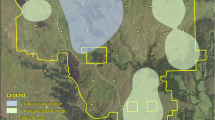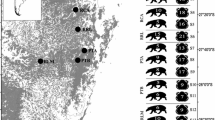Abstract
Four species of burying beetle (Nicrophorus marginatus F., N. tomentosus Weber, N. orbicollis Say and N. defodiens Mannerheim) are attracted to small, fresh mouse carcasses in northern Michigan. The number of burying beetles and their success (burial of a carcass) were greater in woodlands than in edge or field habitats. Species diversity was least in open fields as assessed by two different indices of diversity. Nicrophorus marginatus was the only species captured in large fields (<25 ha). This species was never trapped in small fields (>5 ha) suggesting that a minimum habitat size might be necessary to maintain local populations. In contrast to previous studies which employed pitfall traps baited with a large quantity of carrion, N. tomentosus was caught exclusively in woodlands at single mouse carcasses. In Connecticut woodlands, burying beetle success, assayed as the proportion of carcasses buried and held for 7 days, was significantly greater in larger as compared to smaller woodlands. The limited success of burying beetles in smaller woodlands was due, in part, to a higher rate of scavenging by vertebrates.
Similar content being viewed by others
References
Anderson, R.S. (1982) Resource partitioning in the carrion beetle (Coleoptera: Silphidae) fauna of southern Ontario: ecological and evolutionary considerations. Canad. J. Zool. 60, 1314-25.
Anderson, R.S. and Peck, S.B. (1985) The Insects and Arachnids of Canada: Part 13. Ottawa: Canadian Government Publishing Centre.
Andrewartha, J.G. and Birch, L.C. (1984) The Ecological Web. Chicago: University of Chicago Press.
Bedick, J.C., Ratcliffe, B.C. and Higley, L.G. (1999) Distribution, ecology and population dynamics of the American Burying Beetle Nicrophorus americanus Olivier (Coleoptera: Silphidae) in southcentral Nebraska. J. Ins. Cons. 3, 171-7.
Beninger, V. (1994) Phenology, reproductive biology, and habitat associations of Nicrophorus Fab. (Coleoptera, Silphidae) of the Mer Bleue bog area (Ottawa, Canada). Mem. Entomol. Soc. Canad. 169, 135-43.
Blouin-Demers, G. and Weatherhead, P.J. (2000) A novel association between a beetle and a snake: parasitism of Elaphe obsoleta by Nicrophorus pustulatus. Ecoscience 7, 395-397.
Brothers, T.S. and Spingarn, A. (1992) Forest fragmentation and alien plant invasion of central Indiana old-growth forest. Cons. Biol. 2, 330-2.
Christiansen, M.B. and Pitter, E. (1997) Species loss in a forest bird community near Lagoa Santa in southeastern Brazil. Biol. Cons. 80, 23-32.
Collenge, S.K. (2000) Effects of grassland fragmentation on insect species loss, colonization, and movement patterns. Ecology 81, 2211-26.
Creighton, J.C. and Schnell, G.D. (1998) Short-term movement patterns of the endangered American Burying Beetle Nicrophorus americanus. Biol. Cons. 86, 281-7.
Eggert, A.-K. and Müller, J.K. (1997) Biparental care and social evolution in burying beetles: lessons from the larder. In Social Competition and Cooperation in Insects and Arachnids: Vol II. Evolution of Sociality (J.C. Choe and B.J. Crespi, eds.), pp. 216-36. Princeton, New Jersey: Princeton Press.
Elton, C.S. (1975) Conservation and the low population density of invertebrates inside neotropical rain forest. Biol. Cons. 7, 3-15.
Fuller, M.E. (1934) The insect inhabitants of carrion: a study in animal ecology. Austr. Coun. Sci. Ind. Res. Bull. 82, 1-62.
Golden, D.M. and Crist, T.O. (1999) Experimental effects of habitat fragmentation on old-field canopy insects: community, guild and species responses. Oecologia 118, 371-80.
Hurlburt, S.H. (1971) The nonconcept of species diversity: a critique and alternative parameters. Ecology 52, 577-86.
Klein, B.C. (1989) Effects of forest fragmentation on dung and carrion beetle communities in central Amazonia. Ecology 70, 1715-25.
Kozol, A.J., Scott, M.P. and Traniello, J.F.A. (1988) The American burying beetle, Nicrophorus americanus: studies on the natural history of a declining species. Psyche 95, 167-76.
Lingafelter, S.W. (1995) Diversity, habitat preferences, and seasonality of Kansas carrion beetles (Coleoptera: Silphidae). J. Kans. Entomol. Soc. 68, 214-23.
Lomolino, M.J., Creighton, J.C., Schnell, G.D. and Certain, D.L. (1995) Ecology and conservation of the endangered American burying beetle (Nicrophorus americanus). Cons. Biol. 9, 605-14.
Lomolino, M.V. and Creighton, J.C. (1996) Habitat selection, breeding success and conservation of the endangered American burying beetle Nicrophorus americanus. Biol. Cons. 77, 235-41.
MacArthur, R.H. and Wilson, E.O. (1967) The Theory of Island Biogeography. Princeton, New Jersey: Princeton University Press.
Malcolm, J.R. (1994) Edge effects in central Amazonian forest fragments. Ecology 75, 2438-45.
Ohkawara, K., Suzuki, S. and Katakura, H. (1998) Competitive interaction and niche differentiation among burying beetles (Silphidae, Nicrophorus) in northern Japan. Entomol. Sci. 1, 551-9.
Pukowski, E. (1933) Ökologische untersuchungen an Necrophorus F. Zeitschr. Morph. Ökol. Tiere 27, 518-86.
Ratcliffe, B.C. (1996) The Carrion Beetles (Coleoptera: Silphidae) of Nebraska. Lincoln: University of Nebraska State Museum.
Saunders, D.A., Hobbs, R.J. and Margules, C.R. (1991) Biological consequences of ecosystem fragmentation: a review. Cons. Biol. 5, 18-32.
Scott, M.P. (1998) The ecology and behavior of burying beetles. Ann. Rev. Entomol. 43, 595-618.
Scott, M.P., Traniello, J.F.A. and Fetherston, I.A. (1987) Competition for prey between ants and burying beetles (Nicrophorus spp.): Differences between northern and southern temperate sites. Psyche 94, 325-32.
Shubeck, P.P. (1983) Habitat preferences of carrion beetles in the Great Swamp NationalWildlife Refuge, New Jersey (Coleoptera: Silphidae, Dermestidae, Nitidulidae, Histeridae, Scarabaeidae). J. N. Y. Entomol. Soc. 91, 333-41.
Shubeck, P.P. (1993) An ecotonal study of carrion beetles (Coleoptera: Silphidae) in the Great Swamp National Wildlife Refuge, New Jersey. Entomol. News 104, 88-92.
Smith, R.J. and Heese, B. (1995) Carcass selection in a high altitude population of the burying beetle, Nicrophorus investigator (Silphidae). Southwest. Nat. 40, 50-5.
Trumbo, S.T. (1990a) Interference competition among burying beetles (Silphidae, Nicrophorus). Ecol. Entomol. 15, 347-55.
Trumbo, S.T. (1990b) Regulation of brood size in a burying beetle, Nicrophorus tomentosus (Silphidae). J. Ins. Behav. 3, 491-500.
Trumbo, S.T. (1990c) Reproductive success, phenology, and biogeography of burying beetles (Silphidae, Nicrophorus). Amer. Midl. Nat. 124, 1-11.
Trumbo, S.T. (1992) Monogamy to communal breeding: exploitation of a broad resource base by burying beetles (Nicrophorus). Ecol. Entomol. 17, 289-98.
Trumbo, S.T. (1996) Parental care in invertebrates. Adv. Stud. Behav. 25, 3-51.
Trumbo, S.T. and Thomas, S. (1998) Burying beetles (Coleoptera: Silphidae) of the Apostle Islands, Wisconsin: species diversity, population density and body size. Gr. Lakes Entomol. 31, 85-95.
Walker, T.J. (1957) Ecological studies of the arthropods associated with certain decaying materials in four habitats. Ecology 38, 262-76.
Wilkinson, L. (1989) SYSTAT: The System For Statistics. Evanston, Illinois: SYSTAT Inc.
Wilson, D.S., Knollenberg, W.G. and Fudge, J. (1984) Species packing and temperature dependent competition among burying beetles (Silphidae, Nicrophorus). Ecol. Entomol. 9, 205-16.
Yahner, R.H. (1988) Changes in wildlife communities near edges. Cons. Biol. 2, 333-9.
Zabel, J. and Tscharntke, T. (1998) Does fragmentation of Urtica habitats affect phytophagous and predatory insects differentially? Oecologia 116, 419-25.
Author information
Authors and Affiliations
Corresponding author
Rights and permissions
About this article
Cite this article
Trumbo, S.T., Bloch, P.L. Habitat Fragmentation and Burying Beetle Abundance and Success. Journal of Insect Conservation 4, 245–252 (2000). https://doi.org/10.1023/A:1011390215088
Issue Date:
DOI: https://doi.org/10.1023/A:1011390215088




